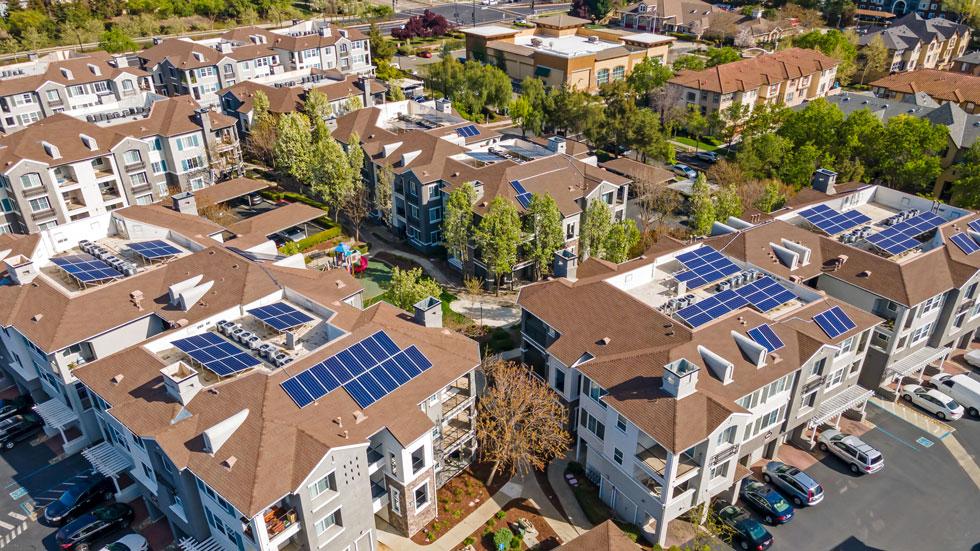
Essex Property Trust, Inc. (NYSE: ESS) President and CEO Angela Kleiman says the REIT’s long-term focus on reducing its environmental impact, increasing support to its communities, and maintaining a commitment to equity is a core strategy that will continue to create value and drive sustainable returns for stakeholders for years to come.
Essex has a decade-plus commitment to sustainability practices, and the new set of goals the REIT established in 2023 to accelerate its ESG initiatives build upon that solid foundation, Kleiman notes.
The West Coast REIT currently has ownership interests in 252 apartment communities, or approximately 62,000 apartment homes. “ESG will continue to be an integral part of our mission to provide great communities in which we live, work, and invest,” Kleiman says.
Most notable among Essex’s new ESG targets is its energy reduction goal, which aims to be consistent with the Paris Agreement and sets the REIT on track for long term greenhouse gas (GHG) reductions across the portfolio. Essex is seeking to reduce Scope One and Scope Two GHG emissions 35% by 2030, whole building water usage by 10%, and waste reduction 50% by 2030.
An ongoing challenge for Essex’s sustainability goals over the years has been data, Kleiman says. “And that’s driven by two factors: technology, which enables timely and accurate reporting, and of course accessibility, because some of this data may not be available to us and it’s a key area of focus for both Essex and the industry,” she adds.
External Recognition
Kleiman acknowledges that one area where it’s harder to quantify the impact, despite its importance, is corporate responsibility. “I do think many companies are trying to navigate this, but for us, we've been pleased with our accomplishments.” Through several ongoing programs and partnerships, Essex provides affordable housing to residents, setting aside approximately $30 million annually to provide 2,455 apartment homes at below-market rents. In 2022, Essex provided rent subsidies to more than 800 employees, at a cost of approximately $5 million.
Essex employees also receive wellness and housing benefits, Kleiman notes, while the REIT provides philanthropic benefits to the community through its Essex Cares program, including partnering with groups such as the Housing Industry Foundation. “We're going to continue to focus our initiatives on corporate responsibility because we believe in supporting our communities, which also fosters a more positive work environment for our associates,” she says. In addition, Essex has committed to donate $3 million to charitable causes within our communities.

Essex’s efforts in corporate social responsibility have not gone unnoticed. It has been named to Newsweek’s list of Most Responsible Companies for three consecutive years and included in Bloomberg’s 2023 Gender Equality Index. What’s notable about Essex is that alongside Kleiman, Essex’s C-suite is 75% women: CFO Barb Pak and Chief Administrative Officer & General Counsel Anne Morrison. Meanwhile, more than 50% of management positions are held by people of color.
“What people don’t know is that this all evolved organically,” Kleiman says. “It has occurred as a result of hiring and elevating employees based on merit, which includes fostering talented individuals that embody the core values of our company and the work that we've done naturally to increase employee engagement, which ultimately enhances alignment and productivity and is certainly, a key driver of our success.”
Favorable Supply/Demand Balance
That success has been demonstrated consistently over the years at Essex, with NOI, core FFO and dividend growth all at industry-leading levels. Kleiman (pictured right) says the multifamily sector remains in a good position today.
Low supply is anticipated to continue in Essex’s markets for the intermediate term, Kleiman says. Meanwhile, on the demand side, “we are in markets that generate the highest GDP growth in the U.S, which has historically translated to leading job and wage growth, thus greater demand for housing. The supply and demand dynamic, which has historically resulted in our West Coast markets delivering among the highest levels of rent growth, and we expect that to continue.”
Kleiman expects the best opportunity for growth to come from Essex’s northern region, especially Northern California, which represents about 40% of the Essex portfolio. She highlights the fundamental backdrop in this region of low supply, alongside some of the best affordability metrics, and potential green shoots on the demand side.
“What I am referring to is the substantial investment and innovation in artificial intelligence. That sector has a significant amount of infrastructure, investments, and demand and potential growth ahead,” Kleiman says. About 85% of AI companies are headquartered in the Bay Area and since Northern California has yet to recover from the pandemic, “it has both recovery ahead and also these potential demand tailwinds to provide a solid long-term growth trajectory.”
Essex attracts a large and diverse renter demographic, Kleiman explains. “Many people think that our portfolio predominantly comprise of technology employees, but we have a well-diversified tenant base, including finance, leisure, hospitality, and education, to name just a few.” The one thing that is slightly different about Essex, she adds, is the median renter age, which has always been higher in Essex’s markets due to the high cost of home ownership, Kleiman says. “We expect that trend to continue.”
Essex has noticed a clear preference for larger units among its tenants as a result of hybrid work and the fact that tenants are remaining renters for longer periods of time, Kleiman says. In response, Essex is looking at opportunities that include repurposing underutilized leasing space into workspaces that residents can use, as well as through densification and placing larger units within its existing buildings that could be permitted under certain zoning codes in California.
Proptech Potential
As Essex tracks the needs of its tenants, and determines how they can be met most efficiently, the REIT will continue to turn to proptech for solutions. Essex has been an active investor in proptech for several years and Kleiman says it has been a key driver in transforming the company’s operating platform. Now, instead of operating each property as an individual building, Essex can group up to 11 properties together as one business unit.
“We do have a unique footprint in that approximately 80% of our communities are within five miles of each other, so that certainly helps. But in order to optimize this kind of an operating synergy, we needed technology,” Kleiman says. While Essex has had this vision for a long time, it’s been the development over the past five years of products such as Funnel online leasing and its customer management functionality that has enabled it to be “highly efficient,” she adds.
Essex continues to pursue opportunities in proptech. Along with other large multifamily companies, including UDR, Inc. (NYSE: UDR) and MAA (NYSE: MAA), Essex is a founding partner of RET Ventures, which focuses on proptech for the multifamily industry, and is a co-founder of the RET Ventures’ Housing Impact Fund, which focuses on energy consumption and housing affordability. This fund plans to invest in technologies that mitigate the environmental impact of new and existing residential real estate, address social issues among residents, and help investors and institutions abide by evolving regulatory guidelines.
Looking ahead, Kleiman says one of the things she’s most excited about for Essex is continuing to transform the operating model. Having completed phase one, the sales and administration side, Essex still has maintenance collections that it is planning to implement over the coming year or two. These are exciting opportunities for Essex that will allow us to be more efficient and allow us to grow and improve operating margins in a durable way.”
